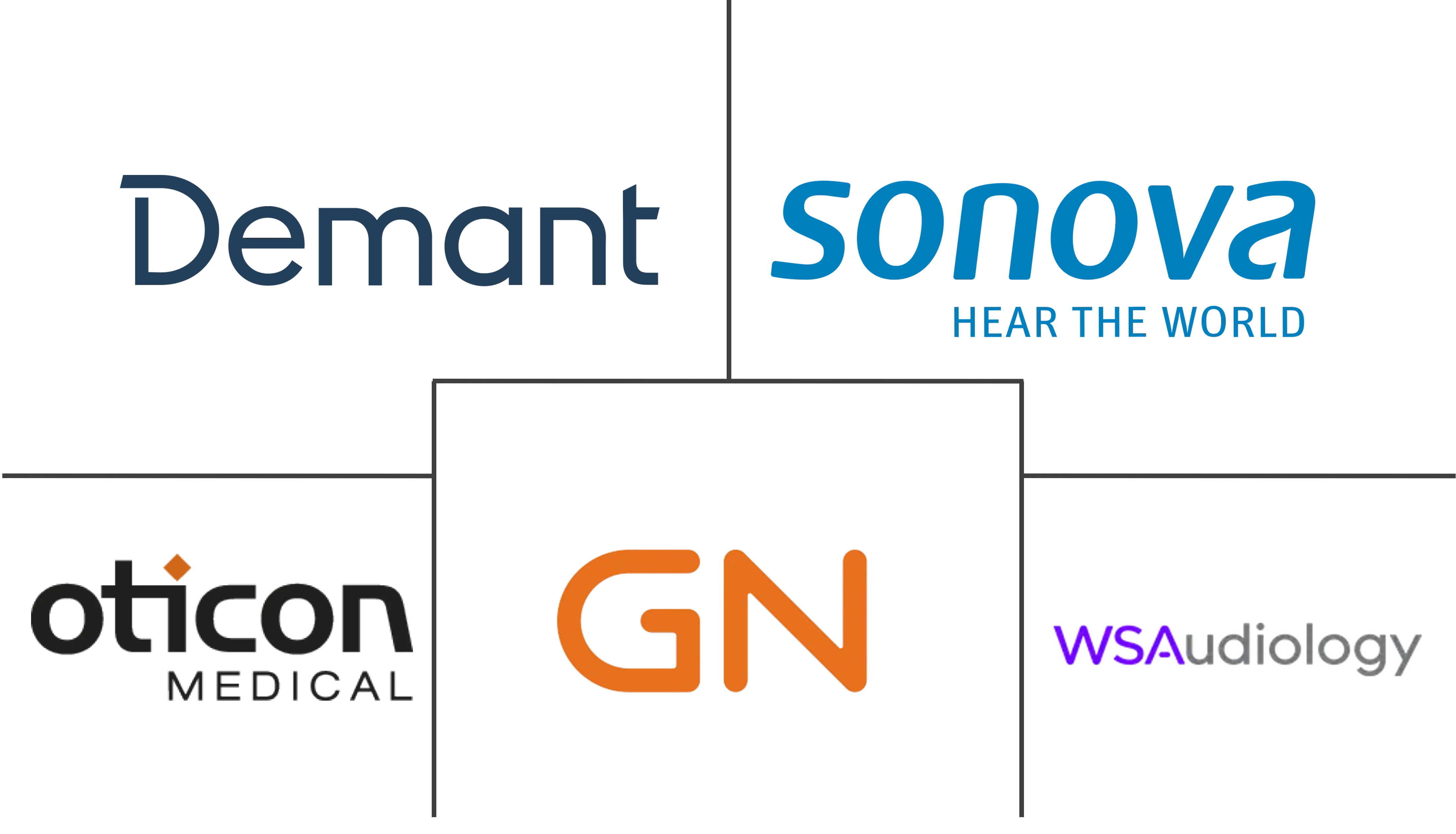Denmark Hearing Aids Market Size and Share
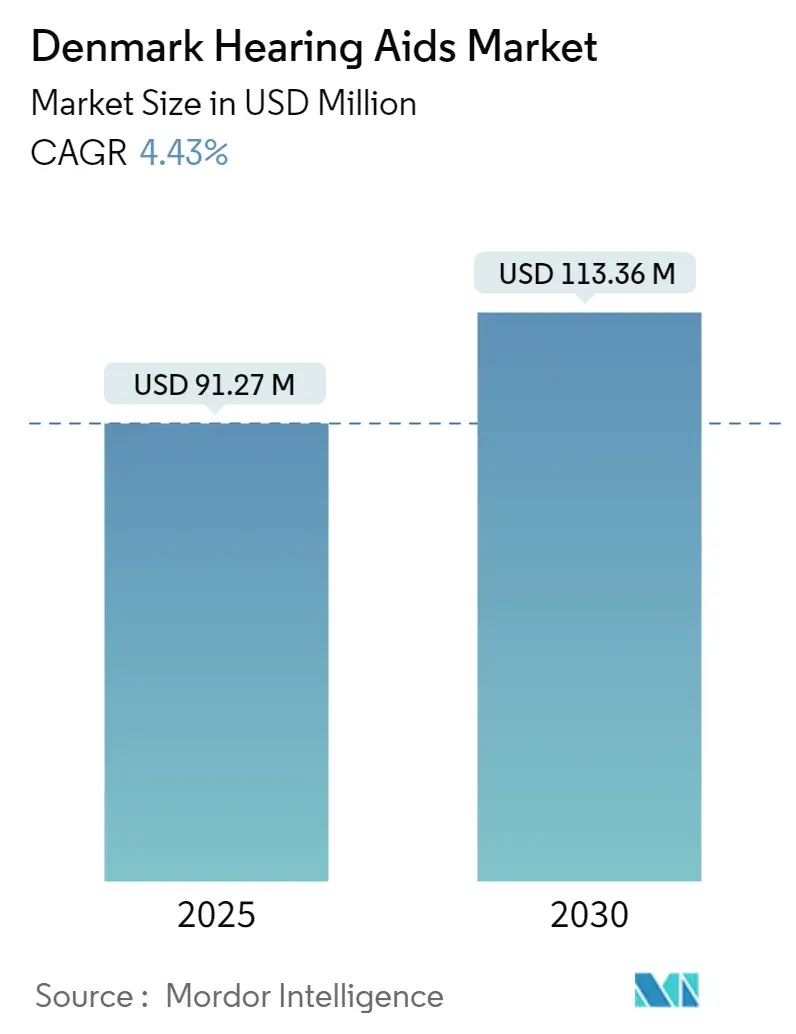
Denmark Hearing Aids Market Analysis by Mordor Intelligence
The Denmark Hearing Aids Market size is estimated at USD 91.27 million in 2025, and is expected to reach USD 113.36 million by 2030, at a CAGR of 4.43% during the forecast period (2025-2030).
Factors such as the rising burden of hearing loss, coupled with the growing geriatric population, technological advancements, and increasing awareness about hearing aid devices, are expected to boost the growth of the Danish hearing aids market over the forecast period.
The rising incidence of hearing loss in the population, owing to the increasing aging population, growing urbanization, and lifestyle changes leading to higher exposure to environmental noise, contributes to the high demand for hearing aids in the Danish market. For instance, a July 2024 article published in Calcified Tissue International highlighted that individuals in Denmark with osteogenesis imperfecta (OI) face a heightened risk of hearing loss (HL). The study noted that HL, often linked to middle ear bone changes in OI, manifests earlier in these individuals, with prevalence escalating with age.
In addition to the above context, it was reported that the younger population has some form of hearing loss, and the incidence of hearing loss has increased among the population aged 75 years and above in Denmark. The high prevalence of hearing loss is expected to drive the demand for technologically advanced hearing aids in the market; this, in turn, is anticipated to bolster market growth over the forecast period.
Moreover, researchers have established a significant link between untreated hearing loss and a heightened risk of cognitive decline, notably dementia. For instance, a January 2024 study by the University of Southern Denmark's Department of Clinical Research revealed that individuals with hearing loss face up to a 13% elevated risk of developing dementia, especially pronounced in those with severe hearing impairment. The research also highlighted that using hearing aids could potentially prevent or postpone the onset of dementia. This finding has led caregivers and healthcare professionals to advocate for hearing aids as a preventive strategy, likely driving market growth during the forecast period.
Furthermore, the introduction of innovative hearing aids by key companies is set to boost their appeal among the target population, further fueling market expansion. For instance, in February 2024, Oticon, Denmark, unveiled the Oticon Intent, the pioneering hearing aid equipped with 4D sensor technology. This innovation discerns each user's listening intentions, catering to individual needs while ensuring a comprehensive auditory experience. Also, this 4D Sensor technology enhances speech comprehension by 15% and aids users in prioritizing sound sources. Such advancements are poised to positively influence market growth in the coming years.
Similarly, in February 2023, Oticon, Denmark, introduced Oticon Real, marking a significant step in their BrainHearing initiative. This device offers users a balanced and detailed auditory experience, adeptly managing both soft and sudden loud sounds and featuring innovative wind and handling noise prevention. Given these technological strides, the heightened adoption of such devices among users is anticipated to increase and significantly drive market growth.
Therefore, with the rising burden of hearing loss, the increasing aging population, the use of digital hearing loss assessment devices for accurate detection of hearing loss, and the increasing adoption of hearing aids among patients suffering from dementia, the demand for hearing aids is expected to increase across Denmark, thereby bolstering the Danish hearing aids market’s growth. However, the high cost of hearing aid devices and the presence of alternative products are likely to impede market growth over the forecast period.
Denmark Hearing Aids Market Trends and Insights
Receiver-in-the-Ear (RITE)/Receiver-in-Canal (RIC) Segment Expected to Witness Significant Growth Over the Forecast Period
Receiver-in-the-ear (RITE) hearing aids are located in the ear with a thin wire connecting it to a small behind-the-ear (BTE) casing. The receiver-in-canal (RIC) device is placed directly in the ear canal and connected to a small BTE unit via a thin wire.
The receiver-in-the-ear (RITE)/receiver-in-canal (RIC) segment is expected to witness significant growth in the Danish hearing aids market owing to factors such as the rising prevalence of hearing loss, coupled with the growing aging population, technological advancements in RITE/RIC hearing aids, and the advantages offered by RITE/RIC.
The increasing recognition of technologically advanced hearing aids by companies is anticipated to increase their demand, which in turn, is expected to augment the segment’s growth over the forecast period. For instance, in May 2024, WSAudiology, a Denmark-based company, reported that the Widex SmartRIC hearing aid was awarded the Golden A’ Design Award in the Medical Devices and Medical Equipment Design category for introducing new angles of natural hearing through its industry-first L-shape design. Thus, the development of technologically advanced hearing aids is expected to propel their adoption among users, which, in turn, is anticipated to bolster the segment’s growth over the forecast period.
Similarly, in February 2023, Oticon, a Denmark-based company, launched Oticon Real in the three top price points in the miniRITE and miniBTE styles, both with and without rechargeability. The improvements in Oticon Real were made through the new Polaris R platform, containing new, extremely fast detectors that capture and adjust annoying and sudden sounds. Thus, such developments are expected to boost the demand for such products in the market, which is anticipated to spur the segment’s growth over the forecast period.
Therefore, owing to the new product launches and growing product recognition, the segment is expected to grow over the forecast period.
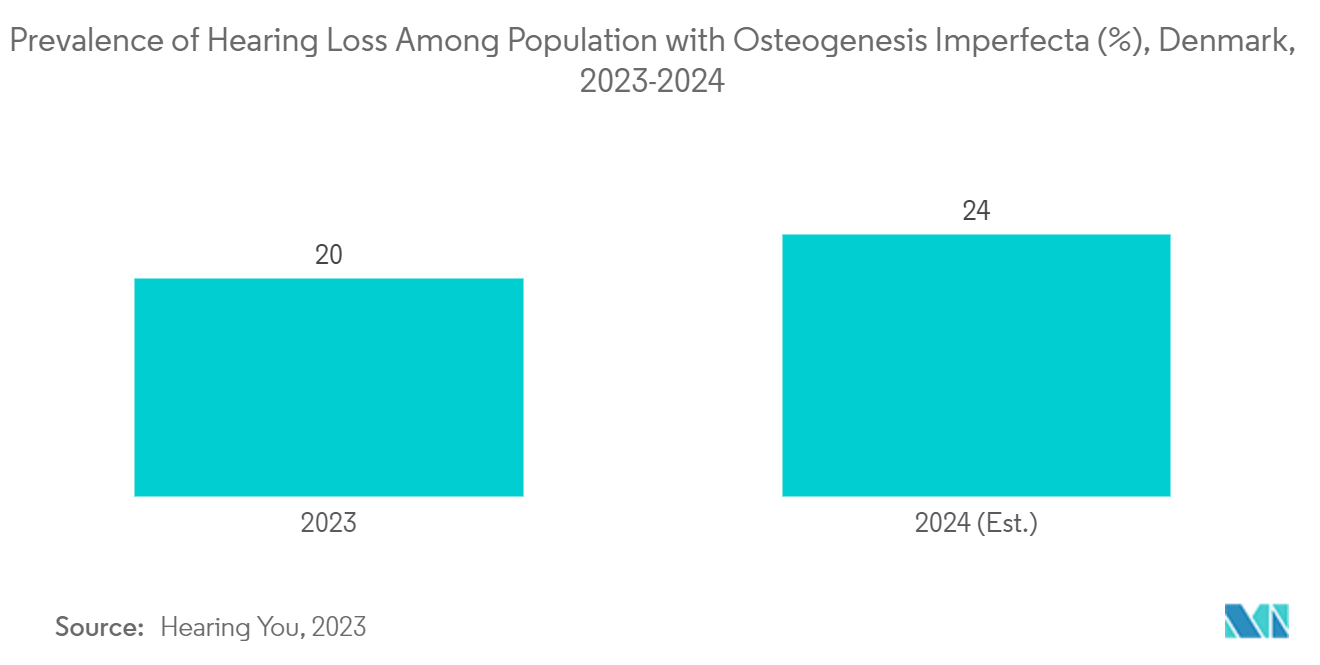
Completely-in-Canal Hearing Aid Segment Expected to Witness Significant Growth Over the Forecast Period
Completely-in-canal hearing aids are custom-fit devices designed to sit partially in the ear canal. Their discreet nature, being less visible than larger models, makes them a preferred choice for individuals seeking subtlety. These aids not only deliver commendable sound quality but also cater to a spectrum of hearing loss levels. The anticipated growth of this segment during the forecast period can be attributed to several factors, such as the inherent advantages of the small, custom design, technological advancements in sound quality and noise reduction, heightened awareness about hearing health, and the recognized benefits of early intervention.
Danish researchers conducted various studies to screen the population for complicated hearing loss and serious ear disorders in hearing-impaired adults before administering hearing aid treatments. For instance, an article published in Frontiers in Digital Health in June 2023 highlighted that hearing loss (HL) detrimentally impacts the quality of life, leading to increased social distancing, early retirement, and heightened risks of anxiety, depression, and dementia.
In addition to the above context, the RESA digital screening method demonstrated a significantly higher accuracy compared to traditional physical assessments by in-person ENT specialists. This digital approach allows ENT specialists to evaluate hearing-impaired individuals remotely, expediting the assessment process and minimizing diagnostic and treatment delays. Consequently, these advanced digital assessment devices facilitate earlier and more precise detection of hearing loss, prompting timely interventions. This trend is expected to drive the demand for hearing aids, thereby bolstering market growth.
Moreover, the rise of technologically advanced hearing aids is set to boost their market presence, driving overall growth. For instance, in August 2024, GN, a pioneer in hearing aid innovation in Denmark, unveiled two new additions to its ReSound Nexia family, the smallest in-the-canal (ITC) hearing aid in a wireless non-rechargeable format and a new wireless rechargeable CROS behind-the-ear (BTE) solution. These innovations not only offer enhanced options for those with hearing impairments but also mark a significant leap into the next era of Bluetooth connectivity.
Therefore, owing to the increasing number of studies related to hearing loss and its impact on overall mental health and new product launches by key players, the segment is expected to grow over the forecast period.
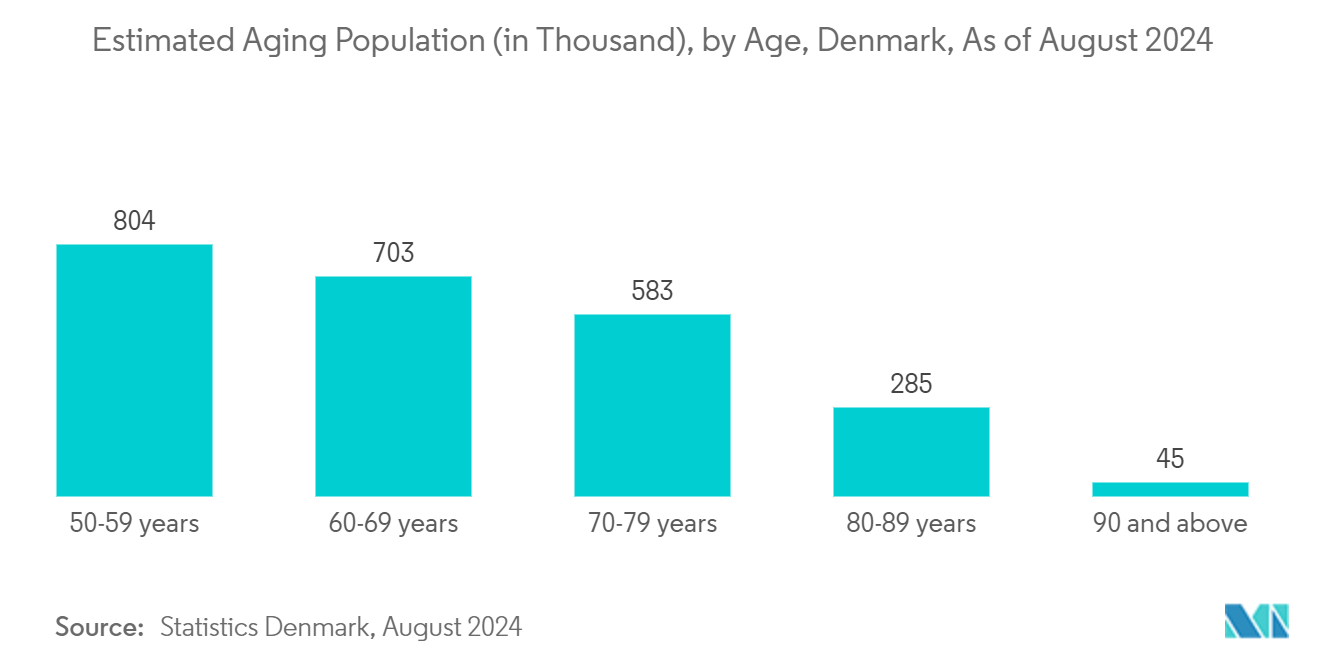
Competitive Landscape
The Danish hearing aids market is consolidated owing to the presence of a small number of key players dominating the market. The players are focusing on developing technologically advanced hearing aids to expand their product offerings and retain their share in the market. Some of the key players in the market are Demant AS, GN Group, Oticon Medical, Sonova, and WS Audiology AS.
Denmark Hearing Aids Industry Leaders
-
WS Audiology A/S
-
Demant A/S
-
GN Group
-
Oticon Medical
-
Sonova
- *Disclaimer: Major Players sorted in no particular order
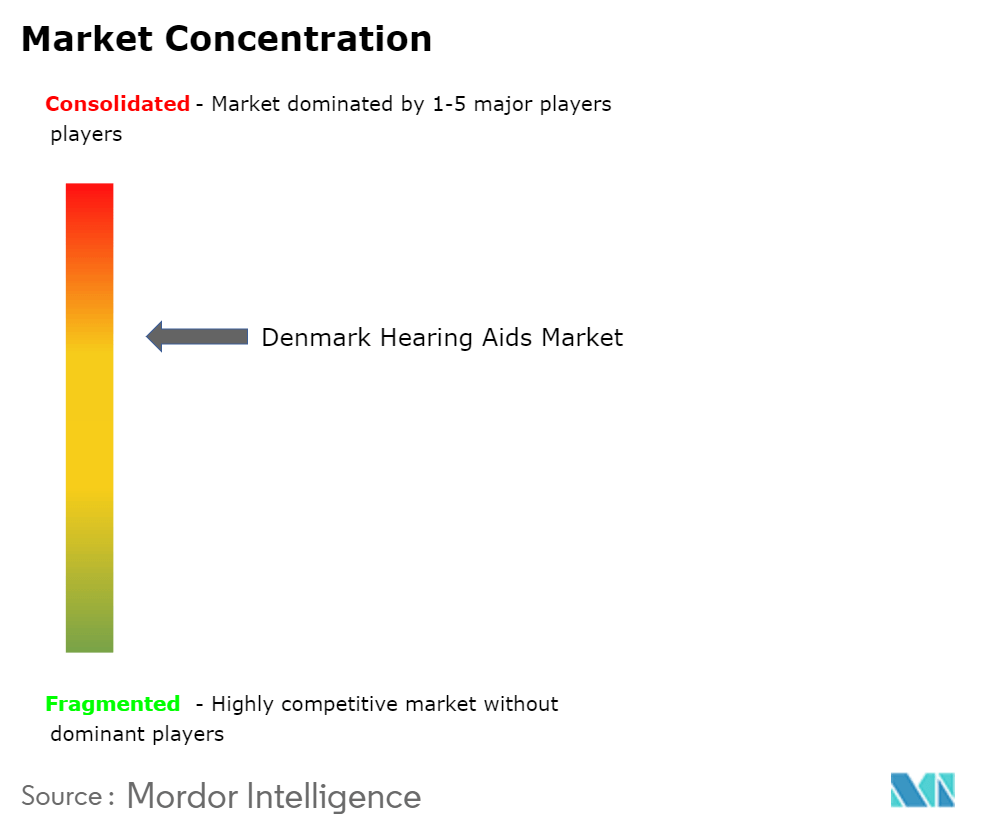
Recent Industry Developments
- June 2024: Audientes AS, a pioneering Danish company specializing in affordable, self-fitting hearing aids and hearables, entered a strategic partnership with SensoDetect AB, a Swedish company. SensoDetect AB focuses on mental health diagnostics, including assessments for ADHD, schizophrenia, and autism, to enhance solutions for both mental and hearing health.
- May 2024: Harman International Industries inaugurated an Audio Engineering Lab in Kvistgaard, a town in North Zealand, Denmark. The lab has been dedicated to developing audio technologies, with a particular emphasis on hearing aids.
Denmark Hearing Aids Market Report Scope
As per the scope of the report, hearing aids are sound-amplifying devices that treat hearing impairment. These devices differ by design, the technology used to achieve amplification, and specific features.
The Danish hearing aids market is segmented by product type, technology, and distribution channel. By product type, the market is segmented into behind-the-ear (BTE), receiver-in-the-ear (RITE)/receiver-in-canal (RIC), in-the-ear (ITE), completely-in-canal (CIC), and other hearing aid devices. The other hearing aid devices segment includes bone conduction hearing aids and contralateral routing of signal (CROS)/bilateral routing of signal (BiCROS). By technology, the market is segmented into conventional hearing aids and digital hearing aids. By distribution channel, the market is segmented into outpatient clinics, retail sales, e-pharmacy, and hospitals. For each segment, the market sizing and forecasts are provided based on value (USD).
| Behind the Ear (BTE) |
| Receiver-in-the-Ear (RITE)/Receiver in Canal (RIC) |
| In-the-Ear (ITE) |
| Completely-in-Canal (CIC) |
| Other Hearing Aid Devices (Bone Conduction Hearing Aids and Contralateral Routing of Signal (CROS)/Bilateral Routing of Signal (BiCROS)) |
| Conventional Hearing Aids |
| Digital Hearing Aids |
| Outpatient Clinics |
| Retail Sales |
| E-pharmacy |
| Hospitals |
| By Product Type | Behind the Ear (BTE) |
| Receiver-in-the-Ear (RITE)/Receiver in Canal (RIC) | |
| In-the-Ear (ITE) | |
| Completely-in-Canal (CIC) | |
| Other Hearing Aid Devices (Bone Conduction Hearing Aids and Contralateral Routing of Signal (CROS)/Bilateral Routing of Signal (BiCROS)) | |
| By Technology | Conventional Hearing Aids |
| Digital Hearing Aids | |
| By Distribution Channel | Outpatient Clinics |
| Retail Sales | |
| E-pharmacy | |
| Hospitals |
Key Questions Answered in the Report
How big is the Denmark Hearing Aids Market?
The Denmark Hearing Aids Market size is expected to reach USD 91.27 million in 2025 and grow at a CAGR of 4.43% to reach USD 113.36 million by 2030.
What is the current Denmark Hearing Aids Market size?
In 2025, the Denmark Hearing Aids Market size is expected to reach USD 91.27 million.
Who are the key players in Denmark Hearing Aids Market?
WS Audiology A/S, Demant A/S, GN Group, Oticon Medical and Sonova are the major companies operating in the Denmark Hearing Aids Market.
What years does this Denmark Hearing Aids Market cover, and what was the market size in 2024?
In 2024, the Denmark Hearing Aids Market size was estimated at USD 87.23 million. The report covers the Denmark Hearing Aids Market historical market size for years: 2019, 2020, 2021, 2022, 2023 and 2024. The report also forecasts the Denmark Hearing Aids Market size for years: 2025, 2026, 2027, 2028, 2029 and 2030.
Page last updated on:
Denmark Hearing Aids Market Report
Statistics for the 2025 Denmark Hearing Aids market share, size and revenue growth rate, created by Mordor Intelligence™ Industry Reports. Denmark Hearing Aids analysis includes a market forecast outlook for 2025 to 2030 and historical overview. Get a sample of this industry analysis as a free report PDF download.
